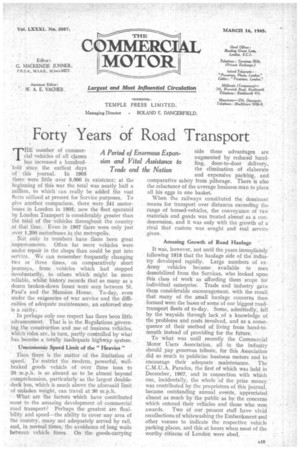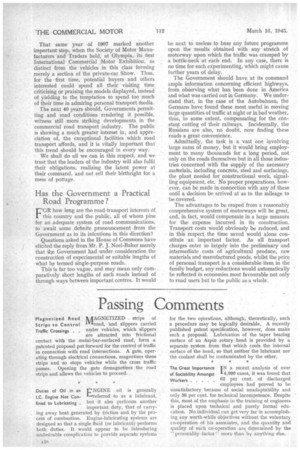,Forty Years of Road Transport
Page 22

Page 23

If you've noticed an error in this article please click here to report it so we can fix it.
THE number of commercial vehicles of all classes has increased a hundredfold since the earliest days of this journal. In 1905 there were little over 3,000 in existence; at the beginning of this war the total was nearly half a million, to which can really be added the vast fleets utilized at present for Service purposes. To give another comparison, there were 241 motorbuses in London in 1905; now the fleet operated by London Transport is considerably greater than the total of the vehicles throughout the country at that time. Even in 1907 there were only just over 1,200 motorbuses rin the metropolis.
Not only in numbers have there been great improvements. Often far more vehicles were under repair in the shops than could be put into service. . We can remember frequently changing two or three times, OD comparatively short • journeys, from vehicles which had stopped • involuntarily, to others Which might be more reliable, whilst history records that as many as a dozen broken-down buses were seen between St. Paurs and the Mansion House. To-day, even under the exigencies of war service and the difficulties of adequate maintenance, an enforced• stop is a rarity.
. In perhaps only one respect has there been little advancement. That is in the Regulations gOverning the construction and use of business vehicles, • which rules are, in turn, partly controlled by what has become a totally inadequate highway system.
• Uneconomic Speed Limit of the " Heavies " Then there is the matter of the limitation of speed. To restrict the modern, powerful, wellbraked goods vehicle of over three tons to 20 m.p.h. is so absurd as to be almost beyond comprehension, particularly as the largest doubledeck bus, which is much above the aforesaid limit of unladen weight, can travel at 30 m.p.h.
• What are the factors which have contributed -most to the amazing development of commercial road transport? Perhaps the greatest are flexihility and speed—the ability to cover any area of the country, many not adequately served by rail, and, in normal times, the avoidance of long waits between vehicle times. On the goods-carrying side these advantages are augmented by reduced handling, door-to-door delivery, the elimination of elaborate and expensive packing, and comparative safety from pilferage. There is also the reluctance of the average business man to place all his eggs in one basket.
When the railways constituted the dominant means for transport over distances exceeding the range of horsed-vehicles, the conveyance of raw materials and goods was treated almost as a condescension, and it was only with the growth of a rival that custom was sought and real service coven.
• Amazing Growth of Road Haulage It was, however, not until the years immediately following 1918 that the haulage side of the industry developed rapidly. Large numbers of Army vehicles vehicles became available to men demobilized from the Services, who looked upon this class of work as affording them scope for individual enterprise. Trade and industry gave them conSiderable encouragement, with the result that many of the small haulage concerns then formed were the bases-of some of our biggest roadtransport fleets of to-day. Some, admittedly, fell by the Wayside through lack of a knowledge of the problems and costs involved, and as a consequence of their method of living from hand-tomouth instead of providing for the future.
To what was until recently the Commercial Motor Users Association, all in the industry should pay generous tribute, for this Association did so much to publicize business motors and to encourage their adequate maintenance. The C.M.U.A. Parades, the first of which was held in December, 1907, and in connection with which one, incidentally, the whole of the prize money was contributed by the proprietors of this journal, became outstanding annual events, appreciated almost as much by the public as by the concerns which entered their vehicles and• those who won awards. Two of our present staff have vivid recollections of whitewashing the Embankment and other venues to indicate the respective vehicle parking places, and this at hours when most of the worthy citizens of London were abed. That same year of 1907 marked another important step, when the Society of Motor Manufacturers and Traders held, at Olympia, its first International Commercial Motor Exhibition, as distinct from the vehicles in this class forming merely a section of the private-ear Show. Thus, for the first time, potential buyers and others interested could spend all their visiting time criticising or praising the models displayed, instead of yielding to the temptation to spend too much of their time in admiring personal transport media.
The next 40 years should, Governments permitting and road conditions rendering it possible, witness still more striking developments in the commercial road transport industry. The public is showing a much greater interest in, and appreciation of, the exceptional facilities which road transport affords, and it is vitally important that this trend should be encouraged in every way.
We shall do all we can in this respect, and we trust that the leaders of the industry will also fulfil their obligations, realizing the latent power at their command, and not sell their birthright for a mess of pottage.
Has the Government a Practical Road Programme ?
FOR how long are the road-transport interests of this country and the public, all of whom pine for an adequate system of road communications, to await some .definite pronouncement from the Government as to its intentions in this direction?
Questions asked in the House of Commons have elicited the reply from Mr. P. J. Noel-Baker merely that tlie Government had under consideration the construction of experimental or suitable lengths of what hp termed single-purpose roads.
This is far too vague, and may mean only comparatively short lengths of such roads instead of through ways between important centres. It would be next to useless to base any future programme upon the results obtained with any stretch of motorway upon which the traffic was cramped by a bottle-neck at each end. In any case, there is no time for such experimenting, which might cause further years of delay.
The Government should have at its command ample information concerning efficient highways, from observing what has been done in America and what was carried out in Germany. We understand that, in the case of the Autobahnen, the Germans have found these most useful in moving large quantities of traffic at night or in bad weather, thus, to some extent, compensating for the constant cutting of• their railways. Incidentally, the Russians are also, no doubt, now finding these roads a great convenience.
Admittedly, the task is a vast one involving large sums of money, but it would bring employment to many thousands for a long period, not only on the roads themselves but in all those industries concerned with the supply of the necessary materials, including concrete, steel and surfacings, the plant needed for constructional work, signalling equipment, etc. No proper preparations, however, can be made in connection with any of these until a decision be arrived at as to the mileage to be covered.
The advantages to be reaped from a reasonably comprehensive system of motorways will be great, and, in fact, would compensate in a large measure for the expense incurred in its construction. Transport costs would obviously be reduced, and in this respect the time saved would alone constitute an important factor. As all transport charges enter so largely into the preliminary and intermediate costs of agricultural produce, raw materials and manufactured goods, whilst the price of personal transport is a considerable item in the family budget, any reductions would automatically be reflected in economies most favourable not only to road users but to the public as a whole.



























































